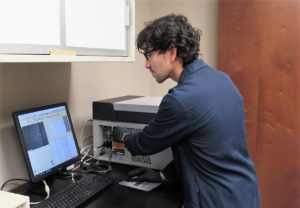Research Chemist Explains X-Ray Fluorescence
January 25, 2019
Expert Corner: ESTIMATION OF TRIVALENT PASSIVATE THICKNESS USING X-RAY FLUORESCENCE by Research Chemist Christian Kissig
Columbia Chemical is widely recognized as one of the industry leaders in the development of effective trivalent passivates for zinc and zinc alloys. A number of years ago, the company recognized the need, both for platers and for R&D purposes, to obtain an accurate value for the thickness of trivalent passivates via nondestructive means. The plater would be able to use this data to improve overall quality control of their finished goods. This method would also aid Columbia’s research and development efforts in the quest for new and improved passivates. Likewise, a correlation could be made between the approximate passivate thickness and its performance in corrosive testing (i.e. salt spray testing, cyclic corrosion testing, etc.).
X-Ray Fluorescence (XRF) emerged as a possible, nondestructive method by which passivate thickness could be reliably measured. XRF relies upon powerful X-Ray beams to excite the inner electrons of the various metals within the solid or liquid analyte. This process creates fluorescent photons that are analyzed by a detector. Each metal on the periodic table has specific orbital energies (an ID tag of sorts), which allow the XRF instrument to identify which metal you are analyzing. Once the XRF instrument identifies the metal, it calculates the thickness value based on how many photons it intercepts. It’s important to note that while the XRF instrument can measure thickness, it will not distinguish between oxidation states (i.e. trivalent vs hexavalent chromium).
Trivalent passivates are not simply comprised of one metal. They are a mixture of chromium oligomers among other atoms. This fact must be conveyed to the XRF instrument for accurate analysis. Columbia developed a statistical factor that is incorporated into the XRF instrument calculations. This allows the instrument to tell the difference between decorative chromium plating (TriCOL Décor) and chromium based passivates (SpectraMATE 25, Tri-V 200UB, etc.) Beyond the analysis of solids, the XRF instrument can determine solution composition as well. This is particularly helpful for quickly evaluating passivate concentration, as well as iron and zinc contamination, which can cause yellowing or poor corrosion resistance.
Thanks to Columbia Chemical’s team for recognizing the need and laying the groundwork for the use of XRF instrumentation to analyze the thickness of trivalent passivates. In addition to benefiting our R&D efforts for current and future passivation analysis and development, this breakthrough also provides platers with an effective means of maintaining a consistent and high quality finish.
Talk with your Columbia Chemical representative about implementing this technology into your plating and passivate applications!
